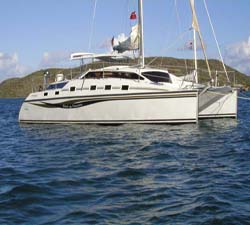PDQ 32
 By Steve Killing
By Steve Killing
Boatbuilder Simon Slater and his designer-father, Alan, are making a significant impact on the multihull industry. In fact, the Canadian boatbuilding industry is noticing a substantial contribution from multihulls that wouldn’t even have Been considered possible 15 years ago. Last month I toured through the PDQ plant and was treated to a sight I haven’t seen in Canada for quite a while-a real production line firing boats out the door to waiting customers! Not only were all the PDQ 32s (and their big sisters, the 36s) sold, but the shop is booked solid for the next six months.
The boat you see here is not radically different from other cats–it’s not even particularly inexpensive. So why is it selling so well?
Like most success stories in the marine industry, it is simply a carefully thought out, well-marketed boat. This combination, linked to a devalued Canadian dollar, secured nine new owners at the Miami boats show–a rare event in anyoneís books.
The original design brief to Alan was simple: create a 32-footer that keeps the performance lineage of the PDQ 36, loses little in interior space, but a lot in expense. For a while the folks at PDQ were concerned that if the project was a success the demand for the larger cat might disappear. It did wane initially, but orders for the 36 are back up again.
The most significant change in layout from their first cat (the PDQ 36) is the switch to an aft-cabin version. The deck raises aft and provides room for two 6 ft. 6 in. by 4 ft. 6 in. berths. Although all boats involve compromises, the key is knowing what not to compromise. Slater has kept the berths large and has ensured that two couples will have private cabins. The starboard hull houses the chart table and electrical panel, with a head forward. On the port side, the galley monopolizes the forward space and includes a real refrigerator like you might find in a trailer home.
Performance is something that PDQ always strives for. Even though it’s hard to determine precisely shy customers will buy a boat, PDQ feels their speed advantage is significant. Slater recognizes that most cruising cats have let weight get out of control and, even more so than in a monohull design, a heavy cat is a slow cat. To stay slim (dry weight is 5,500 lbs.) the builder has used materials carefully. For instance, the hull is a vacuum-bagged, foam-cored laminate with vinylester resin. The structural cross beam or aka, as it is called in multihull lingo, is carbon fibre.
For those not used to cat designs, profile drawings in a magazine are sometimes misleading. All cats suffer aesthetically when viewed in a side-view sailplan drawing. But because they have such great beam they can get away with a higher cabin profile and still look fine in the flesh. So make sure that you take a look at this one at the dock.
The keels, which appear very stubby by monohull standards, are just fine for this boat. Cats don’t need such deep keels for two reasons. First, because multihulls sail at higher speeds than monohulls, and water travels faster over the keel, creating more lift. With this increased lift, less keel area is required. The second reason is that what rides on top of the keels are very slim hulls only 33 inches wide at the waterline. It’s also no coincidence that the shallow flat-bottomed keel will support the boat beautifully either on land or a tidal mud flat.
The cockpit provides four different levels of standing and/or seating so no matter how short or tall, all the guests will be able to see over the cabin top. Moving aft from the cockpit, a central stairway provides safe and comfortable access to the deck and to either ama. Built -in transom stairs offer easy passage to the dock, and the lake or ocean for swimming. Power comes from either twin 9.9 hp Yamaha outboards under the cockpit or straight-drive 18 hp inboards in each of the hulls. I expect this comfortable little cruiser will add to the PDQ success story.
Originally published in Canadian Yachting’s Sailpast 1995 issue.
Specifications
LOA 32 ft. 4 in.
Beam 16 ft.
Draft 2 ft. 10 in.
Weight 7,200 lbs.
Sail Area 500 sq. ft.






















